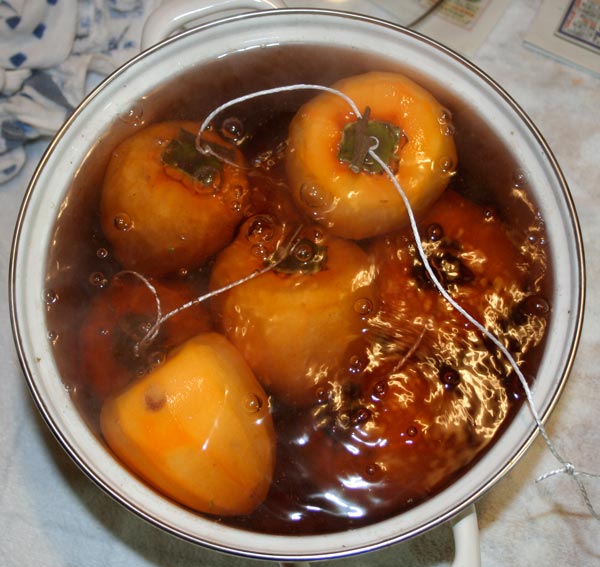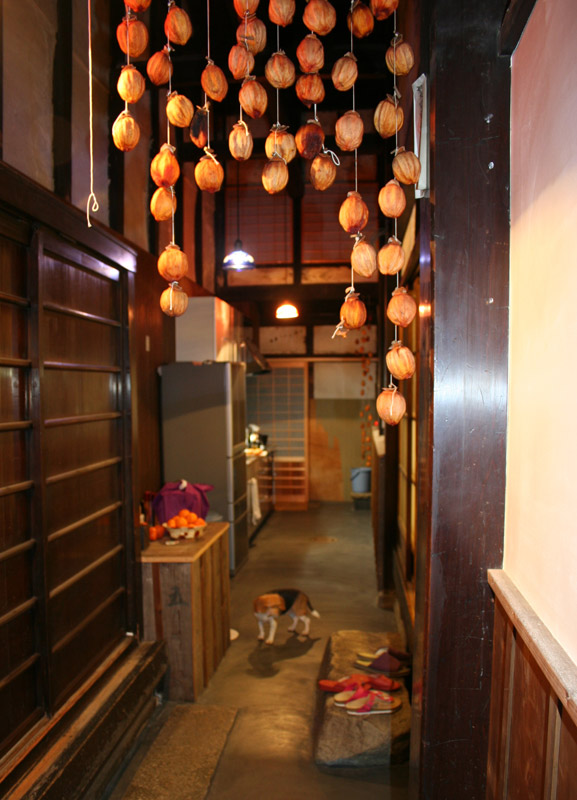How to Make Hoshigaki (Japanese Dried Persimmons)
Persimmons are delicious, but dried persimmons are divine. Totally divine!! Let me qualify that though. There are small, hard, dried out dried persimmons (in Japan they are ‘Made in China’) and then there are big, plump, soft, wet, sticky, gooey dried persimmons — sounds decidedly sexy and they are! These high-quality dried persimmons are very caramelly in taste that brings to mind the finest Medjool dates. And, the best ones, in my opinion, are made from the shigugaki, a persimmon so astringent that it simply cannot be eaten fresh. However, peel it and hang outside for 4-6 weeks and you have a luscious fruit meets caramel angelic delight.
Best of all, making hoshigaki is really easy, and it is fun. Gather some friends or family and make a big bunch of them and give some out to people for year end presents!
Any kind of persimmon can be used but the two most popular, I think, are the hachiya and shibu varieties.
The Fruit
When harvesting or purchasing persimmons for drying, the ones with a bit of the branch and stem still attached will make it easiest to securely attach the string. However, wooden skewers and so on can be improvised.
The fruit must be peeled, so you will want to select fruit that is firm and underripe enough to peel easily and handle easily.
Peeling
Some people use a knife to peel, but I just use a general fruit and vegetable peeler — like you would use to peel a carrot. If you are doing a large batch of hoshigaki, you might want to have several different peelers on hand. I have found that new, very sharp ones are not as efficient to use as an older, somewhat dull one. A brand new sharp peeler seems to cut too deep the flesh.
I start at the top of the persimmon and go around it a few times, being careful not to hit and weaken the attached stem which needs to remain firmly in place during the drying process. Next, I peel the remainder vertically, from top to bottom.
The peels can be saved and dried and used to flavor tsukemono, if you make your own. Tsukemono is very easy to make with local vegetables and is healthy and tasty.
After peeling, some people say to use hot water or distilled alcohol to sterilize the surface of the peeled fruit. I have done this by dunking them in a pot of hot water or a pot of shochu. I doubt this really sterilizes the fruit, and, once it is hung outside, it is going to be in contact with no shortage of germs, not to mention the odd crow, weasel, house cat and so on. I usually neglect the sterilized step and have not experienced any negative result. If it is your first time to make hoshigaki, to be on the safe side, maybe not skip this step. If you can’t get shochu, just use some cheap vodka or similar spirit.
Stringing and Hanging
I prefer a thick, cotton string to string them up with. As the fruit hangs, one side will usually be in strong contact with the string, if the string is thin, it will cut into the fruit as it hangs. (To a certain degree, this is unavoidable.) Also, each string of persimmons will be quite heavy and as you move and hang the strings, your hands will appreciate a thicker string as it won’t cut into them.
Cut the string into about 1 meter lengths and tie off the two ends so they don’t fray. The number of fruit to attach to a string will depend on the persimmon’s size. As I have only made hoshigaki in Japan, I go with the local lucky number seven. I don’t tie knots around each stem, but just wrap the string around several times, as it will be easier to remove when done drying. Knots of course will make handling and moving the strings of fruit easier. However, I find it unnecessary.
Hang the strings of persimmons under the eave of a roof or some other place where they will get plenty of sun and breeze but be protected from rain.
Carefully hang the strings of persimmons and let Mother Nature take care of the magic that will transform them from inedible mouth puckering stringent horror to and angelic caramelly fruit delight.
Drying
After about a week, the persimmons will start to shrivel and the surface will begin to wrinkle. Every few days, you can gently kneed them. This will make them extra creamy and gooey inside. I have not always done this and I think the difference is noticeable. So, you shouldn’t skip this one.
As the fruit dries, a white substance will start to appear on the surface. That is sugar. Of course, rain will wash it right off and that would be a tragedy.
How long to dry depends on the size of the fruit and the environmental conditions. Three to 6 weeks is the average time span, I think. See the photos at the end of the post — that is the goal. (I will get some better photos of hoshigaki up as soon as this batch are done. The photos here are a little over-dried, I think.)

The Final Product - These are maybe over-dried. (Note the absence of sugar on the surface due to rain contact.)
A final step that I am not going to cover here is to let the dried persimmons rest in rice straw for several days. I have done this twice and failed once because I left them in the straw too long and they got moldy.
The rice straw introduces microorganisms that, as I understand it, further reduce the water content and increase the volume of sugar and whiteness of the surface. I need to learn more about this, but the step is not essential, I think.
One thing though, if you can give friends or family a gift of homemade dried persimmons lovingly nested in freshly harvested rice straw, I guarantee they are going to be 100% blown away!!
How to eat hoshigaki?
When Japanese eat fruit such as apples and peaches, they always carefully peel and cut them into sections — eating a whole apple and just leaving the core is the domain of ‘dirty old men’ (as I have been instructed). As far as I can see, when Japanese eat hoshigaki, they just eat them as is. There are some wagashi confections that are a hoshigaki hollowed out and filled with various wagashi concoctions. These are a wonderful winter treat and usually fairly expensive.
Hoshigaki are one of my all time favorite things in the world to eat – in my mind they are tied with Medjool dates as the best dried fruit. Perhaps the flavors are more complex than dates. Making them and observing the drying process is a lot of fun too.








No comments:
Post a Comment